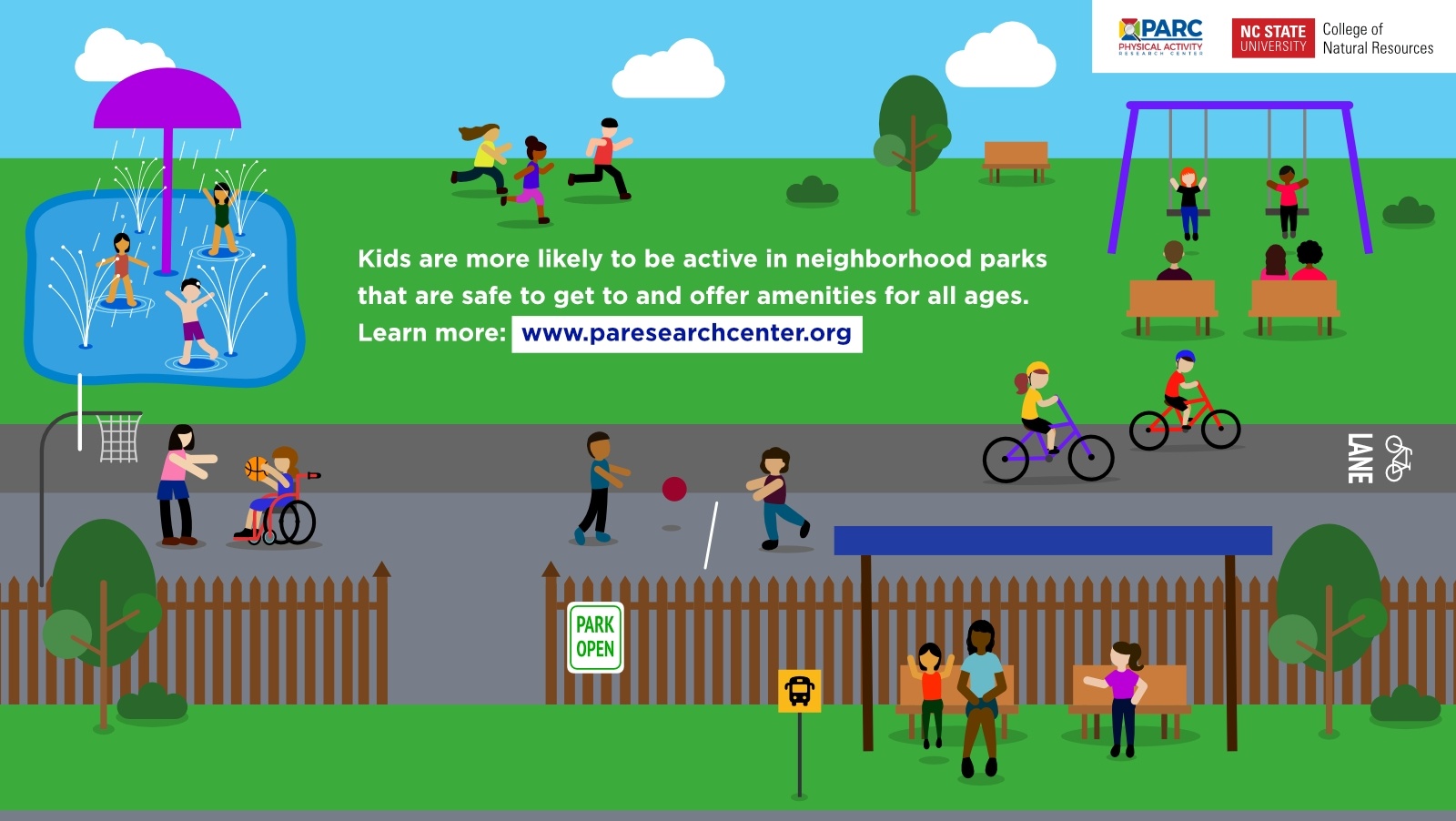Guest Authors:
Aaron Hipp, PhD — Associate Professor of Community Health and Sustainability, Department of Parks, Recreation, and Tourism Management
Myron Floyd, PhD — Dean of the College of Natural Resources, NC State University
Play.
As parents, we want our kids to be able to play and to play outdoors.To run, climb, swing, slide, and laugh care-free. Parks in our neighborhoods should provide these opportunities for our children. To offer this, Parks must be S.A.F.E. That is, Safe, Accessible, Facilitate a variety of experiences, and for Everyone.
As one of four projects for the Physical Activity Research Center, the NC State team sought to understandhow children from different racial and ethnic groups use parks and playgrounds, and how the features and programs in parks and surrounding neighborhood contexts might affectwho visits and what play was occurring in parks. Across the parks, we mapped and observed how children used specific features and amenities and surveyedparents to evaluate who was using the park when and where.
Safe
We focused one part of our evaluation on linking reported crime around 20 parks in New York City time matched to the 97 days we systematically observed play in the parks. Lower park use was related to higher crime reports. This was especially the case for children using the park and even more so for girls (ages 5 to 10) using the parks. Comparing the number of violent crimes near a park during the preceding three months to the number of girls in the park showed an increase in crime was associated with up to 29% fewer girls in the park. Interestingly, for those children and adults who were observed in parks, regardless of nearby crime, their physical activity, or play, levels were unchanged.
Accessible
A related evaluation of the same 20 New York City parks surveyedparents within the parkson their perceptions of neighborhood conditions, including walkability. Similar to other studies, we found variety in land uses (e.g., a mix of shops and public spaces) around the parks and walkable streets wereassociated with greater use. Reflecting the crime results, lower perceived safety around the park was associated with lower use.
Facilitate a variety of experiences
Park and playground spaces must provide opportunities for moving, playing, and discovery. Through almost 4,000 park observations we found late afternoon and early evenings during the school year to be a popular time to visit neighborhood parks, with summer evenings (6-7pm) the most visited. Informally organized spaces, that is spaces without a coach or instruction, but with equipment and some nearby supervision, were popular spaces in parks. In one example, a New York City Parks employee brought out hula hoops, cones, and balls and just placed them near the playsets. Kids were instantly attracted to this new experience that was low cost and low resourced. Across parks, children were most drawn to playground equipment, but also swing sets and basketball courts, as well as splash pads during warmer months. The least used areas by children were baseball diamonds and handball courts.
For Everyone
Our project focused on parks in neighborhoods with majority minority populations; specifically Asian, Latinx, and Black. Across race, ethnicity, and gender there was little difference in use and activity within parks for children between 5 and 10 years of age. However, we did find a significant difference in use and activity amongst teens. Across race and ethnicity there was less use and activity among girls. For boys, use decreased, except among Black teens, but physical activity level remained consistent. There were also some differences in use of space, most notably more use of basketball courts by all teen boys. The noted spaces of high use and activity - playgrounds, swings, and splash pads - all showed less use by teens.
Steps to a S.A.F.E. Park
Some first steps communities can take to ensure their parks are S.A.F.E. include:
- Inter-departmental and community collaboration to improve safety and decrease presence of crime near parks and playgrounds.
- When crime does occur, work together quickly to bring forward positive interactions and experiences through programmingin and near parks. This may include picnics, concerts, and/or protests and other special eventsto bring people together as a community united against crime.
- Improve connectivity between neighborhoods and parks including stop signs/lights and cross walks at all intersections touching a park.
- Provide shaded places for parking and locking bikes, scooters, and strollers to incentivize active transportation to parks.
- Include a variety of facilities and equipment to encourage structured (playground) and unstructured (open space; brightly colored patterns painted on hardscape) play.
- Increase light, mobile play opportunities including equipment such as cones, balls, and hula hoops.
- Temporary and mobile equipment may be more conducive to social distancing by using equipment and zones to spread out play across open spaces including seldom used baseball diamonds.
- Acknowledge all kids, regardless of age, gender, race/ethnicity, want to and enjoy play, but there are differences in what this play may look like and what spaces are preferred. Again, providing variety and temporary equipment, spaces, and experiences may increase park use and play.









